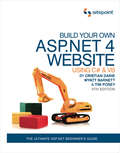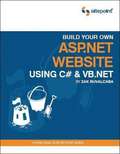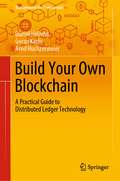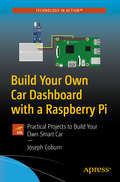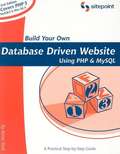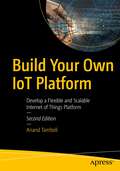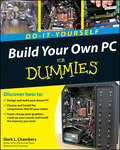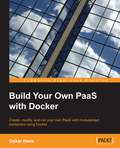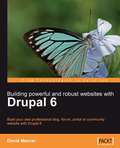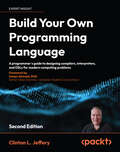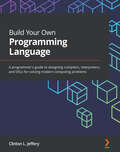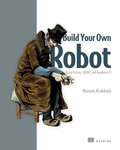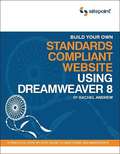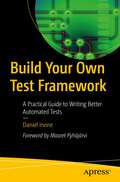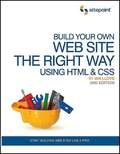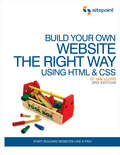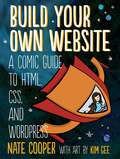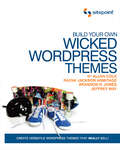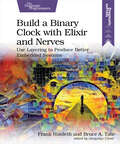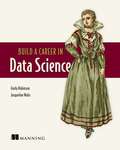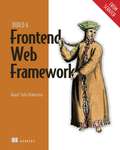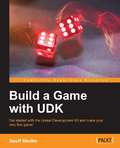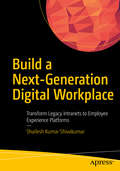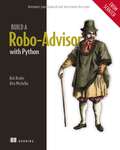- Table View
- List View
Build Your Own ASP.NET 4 Web Site Using C# & VB, 4th Edition: Using C# & VB
by Cristian Darie Timmothy Posey Wyatt BarnettBuild Your Own ASP.NET 4 Web Site Using C# & VB is aimed at beginner ASP.NET developers wanting to develop their skills, web designers wanting to move into server-side programming, and experienced developers making the leap from ASP to .NET.Readers will learn:language and programming basicshow to construct ASP.Net Web Pageshow to build web applicationsto use validation controlsdatabase design and developmenthow to use ADO.NEThow to manage data and contenthow to integrate Ajax and jQuerythe role of MVC... all in the process of successfully developing and deploying a working intranet site for a fictional company.
Build Your Own ASP.NET Website Using C# & VB.NET
by Zak RuvalcabaA tutorial style book for absolute beginners that walks readers through an introduction to databases and programming concepts and then shows them how to build practical applications using Microsoft's technology. Build Your Own ASP.NET Website Using C# & VB.NET guides readers through obtaining, installing and configuring all the necessary software to develop dynamic Websites. Then, it takes readers step-by-step through the process of creating full-blown, practical applications including an intranet, shopping cart with Paypal credit card processing and more. Throughout, the book focuses on best-practice code, ensuring application security and creating professional error handling routines. Unlike most beginner books, SitePoint allow readers to choose between two programming languages, VB.NET or c#, when creating any of the applications in the book.
Build Your Own Blockchain: A Practical Guide to Distributed Ledger Technology (Management for Professionals)
by Arnd Huchzermeier Daniel Hellwig Goran KarlicThis book provides a comprehensive introduction to blockchain and distributed ledger technology. Intended as an applied guide for hands-on practitioners, the book includes detailed examples and in-depth explanations of how to build and run a blockchain from scratch. Through its conceptual background and hands-on exercises, this book allows students, teachers and crypto enthusiasts to launch their first blockchain while assuming prior knowledge of the underlying technology. How do I build a blockchain? How do I mint a cryptocurrency? How do I write a smart contract? How do I launch an initial coin offering (ICO)? These are some of questions this book answers. Starting by outlining the beginnings and development of early cryptocurrencies, it provides the conceptual foundations required to engineer secure software that interacts with both public and private ledgers. The topics covered include consensus algorithms, mining and decentralization, and many more. “This is a one-of-a-kind book on Blockchain technology. The authors achieved the perfect balance between the breadth of topics and the depth of technical discussion. But the real gem is the set of carefully curated hands-on exercises that guide the reader through the process of building a Blockchain right from Chapter 1.” Volodymyr Babich, Professor of Operations and Information Management, McDonough School of Business, Georgetown University"An excellent introduction of DLT technology for a non-technical audience. The book is replete with examples and exercises, which greatly facilitate the learning of the underlying processes of blockchain technology for all, from students to entrepreneurs.” Serguei Netessine, Dhirubhai Ambani Professor of Innovation and Entrepreneurship, The Wharton School, University of Pennsylvania"Whether you want to start from scratch or deepen your blockchain knowledge about the latest developments, this book is an essential reference. Through clear explanations and practical code examples, the authors take you on a progressive journey to discover the technology foundations and build your own blockchain. From an operations perspective, you can learn the principles behind the distributed ledger technology relevant for transitioning towards blockchain-enabled supply chains. Reading this book, you'll get inspired, be able to assess the applicability of blockchain to supply chain operations, and learn from best practices recognized in real-world examples." Ralf W. Seifert, Professor of Technology and Operations Management at EPFL and Professor of Operations Management at IMD
Build Your Own Car Dashboard with a Raspberry Pi: Practical Projects to Build Your Own Smart Car
by Joseph CoburnCreate your own car engine control unit (ECU) with a simple Raspberry PI while building the necessary skills to produce future more advanced projects. Once you've worked through the projects in this book, you'll have a smart car and the coding knowledge needed to develop advanced hardware and software projects.Start by understanding how the Pi works, and move on to how to build hardware projects, use the GPIO pins, and install the system. Then add to that a solid understanding of software development principles and best practices, along with a good grasp of Python (v3.6+) and Python/software best practices. More than just how to code in Python, you'll learn what it takes to write production grade software, defensive code, testing, deployments, version control, and more. Internalize industry best practices while going further with valuable software development techniques such as defensive programming.The concepts introduced are essential to ensuring that software can function under unexpected circumstances. Can you imagine what would happen if your mobile phone could not cope with a call from an unknown number, or you had to set you microwave in increments of 6 seconds? While testing avoids edge cases such as these, defensive programming is one of the building blocks of software development.What You'll LearnHone test driven development in Python skillsDebug software and hardware project installationsWork with the GPIO ports of the Pi to feed your software real-world hardware informationWho This Book Is ForPeople who like working on cars and want to learn Raspberry Pi and software development but don’t know where to start.
Build Your Own Database-Driven Website Using PHP and MySQL, Third Edition
by Kevin YankBuild Your Own Database-Driven Website Using PHP and MySQL is a practical guide for first-time users of PHP and MySQL that teaches readers by creating a fully working Content Management System, Shopping Cart and other real-world applications. There has been a marked increase in the adoption of PHP, most notably in the beginning to intermediate levels. PHP now boasts over 30% of the server side scripting market (Source: http://www.php.weblogs.com ). The previous edition sold over 17,000 copies exclusively through http://www.sitepoint.com alone. With the release of PHP 5, SitePoint have updated this bestseller to reflect best practice web development using PHP 5 and MySQL 4. The 3rd Edition includes more code examples and also a new bonus chapter on structured PHP Programming which introduces techniques for organizing real world PHP applications to avoid code duplication and ensure code is manageable and maintainable. The chapter introduces features like include files, user-defined function libraries and constants, which are combined to produce a fully functional access control system suitable for use on any PHP Website.
Build Your Own IoT Platform: Develop a Flexible and Scalable Internet of Things Platform
by Anand TamboliEvery solution that is in some way related to the IoT needs a platform; learn how to create that platform with us. This book is about being agile and reducing your time to market without breaking the bank. It is about designing something that can scale incrementally without rework and potentially disrupting the current work.So, the key questions are: What does it take? How long does it take? And, how much does it take to build your own IoT platform? This book answers these questions and provides you with step-by-step guide to building your own IoT platform. In this book, the author highlights what the core of an IoT platform looks like. There are always some must-haves and some nice-to-haves. This book distinguishes the two and focuses on building the must-haves. Building your IoT platform is not only the most significant cost-saver but can also be a satisfying learning experience. This edition will extend your work with a sample project to clarify the concepts and show you the possibilities. Additional chapters will also shed some light on the hardware interface and considerations.What You Will Learn· Master how to architect an interconnected system and develop a flexible platform architecture· Understand how to prioritize system requirements with a bottom-up approach· Design and build a robust IoT communications platform· Create an end-to-end application using guidelines in this book Who Is This Book ForIoT developers with basic-to-intermediate programming skills, small business owners, as well as entrepreneurs and startup founders would benefit from this book
Build Your Own PC Do-It-Yourself For Dummies
by Mark L. ChambersIf you've dreamed about having a customized multimedia PC or one tricked out for your favorite games, build your own and make your dreams come true! Build Your Own PC Do-It-Yourself For Dummies makes it easy. Not only is building your own PC a really rewarding project, it can also save you a nice chunk of cash. This step-by-step guide helps you decide what you need, teaches you what all those computer terms mean, and tells you exactly how to put the pieces together. It shows you: What tools you need (not as many as you might think!) All about operating systems How to install CD and DVD drives The scoop on sound and video, and how to put a sound system together from start to finish How to connect a monitor and install a modem All about setting up and configuring the hard drive Secrets for securing your system, and more Included is a bonus DVD showing you how to install the motherboard, CPU, RAM, ports, hard drive, video and sound cards, a DVD drive, and more. With Build Your Own PC Do-It-Yourself For Dummies, you can have the computer you want plus the satisfaction of doing it yourself! Note: CD-ROM/DVD and other supplementary materials are not included as part of eBook file.
Build Your Own PaaS with Docker
by Oskar HaneThis book is intended for those who want to take full advantage of separating services into module containers and connect them to form a complete platform. It will give you all the insights and knowledge needed to run your own PaaS.
Build Your Own Professional Blog, Forum, Portal or Community Website with Drupal 6
by David MercerDescription of how to design and build a web site using the Drupal CMS tool.
Build Your Own Programming Language: A programmer's guide to designing compilers, interpreters, and DSLs for modern computing problems
by Clinton L. JefferyLearn to design your own programming language in a hands-on way by building compilers, using preprocessors, transpilers, and more, in this fully-refreshed second edition, written by the creator of the Unicon programming language. Purchase of the print or Kindle book includes a free PDF eBookKey FeaturesTakes a hands-on approach; learn by building the Jzero language, a subset of Java, with example code shown in both the Java and Unicon languagesLearn how to create parsers, code generators, scanners, and interpretersTarget bytecode, native code, and preprocess or transpile code into a high-level languageBook DescriptionThere are many reasons to build a programming language: out of necessity, as a learning exercise, or just for fun. Whatever your reasons, this book gives you the tools to succeed. You’ll build the frontend of a compiler for your language and generate a lexical analyzer and parser using Lex and YACC tools. Then you’ll explore a series of syntax tree traversals before looking at code generation for a bytecode virtual machine or native code. In this edition, a new chapter has been added to assist you in comprehending the nuances and distinctions between preprocessors and transpilers. Code examples have been modernized, expanded, and rigorously tested, and all content has undergone thorough refreshing. You’ll learn to implement code generation techniques using practical examples, including the Unicon Preprocessor and transpiling Jzero code to Unicon. You'll move to domain-specific language features and learn to create them as built-in operators and functions. You’ll also cover garbage collection. Dr. Jeffery’s experiences building the Unicon language are used to add context to the concepts, and relevant examples are provided in both Unicon and Java so that you can follow along in your language of choice. By the end of this book, you'll be able to build and deploy your own domain-specific language.What you will learnAnalyze requirements for your language and design syntax and semantics.Write grammar rules for common expressions and control structures.Build a scanner to read source code and generate a parser to check syntax.Implement syntax-coloring for your code in IDEs like VS Code.Write tree traversals and insert information into the syntax tree.Implement a bytecode interpreter and run bytecode from your compiler.Write native code and run it after assembling and linking using system tools.Preprocess and transpile code into another high-level languageWho this book is forThis book is for software developers interested in the idea of inventing their own language or developing a domain-specific language. Computer science students taking compiler design or construction courses will also find this book highly useful as a practical guide to language implementation to supplement more theoretical textbooks. Intermediate or better proficiency in Java or C++ programming languages (or another high-level programming language) is assumed.
Build Your Own Programming Language: A programmer's guide to designing compilers, interpreters, and DSLs for solving modern computing problems
by Clinton L. JefferyWritten by the creator of the Unicon programming language, this book will show you how to implement programming languages to reduce the time and cost of creating applications for new or specialized areas of computingKey FeaturesReduce development time and solve pain points in your application domain by building a custom programming languageLearn how to create parsers, code generators, file readers, analyzers, and interpretersCreate an alternative to frameworks and libraries to solve domain-specific problemsBook DescriptionThe need for different types of computer languages is growing rapidly and developers prefer creating domain-specific languages for solving specific application domain problems. Building your own programming language has its advantages. It can be your antidote to the ever-increasing size and complexity of software.In this book, you'll start with implementing the frontend of a compiler for your language, including a lexical analyzer and parser. The book covers a series of traversals of syntax trees, culminating with code generation for a bytecode virtual machine. Moving ahead, you'll learn how domain-specific language features are often best represented by operators and functions that are built into the language, rather than library functions. We'll conclude with how to implement garbage collection, including reference counting and mark-and-sweep garbage collection. Throughout the book, Dr. Jeffery weaves in his experience of building the Unicon programming language to give better context to the concepts where relevant examples are provided in both Unicon and Java so that you can follow the code of your choice of either a very high-level language with advanced features, or a mainstream language.By the end of this book, you'll be able to build and deploy your own domain-specific languages, capable of compiling and running programs.What you will learnPerform requirements analysis for the new language and design language syntax and semanticsWrite lexical and context-free grammar rules for common expressions and control structuresDevelop a scanner that reads source code and generate a parser that checks syntaxBuild key data structures in a compiler and use your compiler to build a syntax-coloring code editorImplement a bytecode interpreter and run bytecode generated by your compilerWrite tree traversals that insert information into the syntax treeImplement garbage collection in your languageWho this book is forThis book is for software developers interested in the idea of inventing their own language or developing a domain-specific language. Computer science students taking compiler construction courses will also find this book highly useful as a practical guide to language implementation to supplement more theoretical textbooks. Intermediate-level knowledge and experience working with a high-level language such as Java or the C++ language are expected to help you get the most out of this book.
Build Your Own Robot: Using Python, CRICKIT, and Raspberry PI
by Marwan AlsabbaghA DIY guide to bringing your first robot to life with cheap and basic components.Build Your Own Robot introduces you to the exciting world of robotics in a way that&’s fun and affordable! You&’ll build your own real robot with easy-to-find hardware and free open source software. Plus, all the components you need can be assembled with simple tools like a screwdriver. In Build Your Own Robot you&’ll learn how to: Use cameras to capture photos and let your robot see Add cameras and basic computer vision Coordinate DC motors to move your robot Write a web app to control your robot Set up controls for joysticks Read QR codes to find and identify objects This book shows you how anyone can start building their own robot—no special soldering or electronic skills required. All you need is some basic Python know-how to get started. From scratch, you&’ll go hands-on with DC motors, touch sensors, custom shell scripting, joystick controls, and even face detection for your robot friend. About the technology You can build your own robot! With this book, you&’ll use readily-available hardware and author Marwan Alsabbagh&’s clear step-by-step instructions to create a robot that moves, manipulates objects, and responds to its environment. Along the way, you&’ll learn some serious skills like computer vision, networking, and the basics of robotics programming. About the book Build Your Own Robot is a project-based guide that takes you from spinning your first DC motor to programming a mobile robot that you can control from your phone or computer. You&’ll write simple Python code to help your new friend spin, move, and find its way. You&’ll even teach it to track faces and fetch snacks. Plus, a helpful hardware purchasing guide makes it easy to find exactly what you need to get started! What's inside Coordinate DC motors to move your robot Write a web app to control your robot Adding cameras and basic computer vision Read QR codes to find and identify objects About the reader Examples use simple Python code. No special skills or expensive tools required. About the author Marwan Alsabbagh is a seasoned software developer, who has studied mathematics and computer science at McGill University. The technical editor on this book was Alexander Ryker. Table of Contents 1 What is a robot? 2 Getting started 3 Driving the robot 4 Creating a robot shell 5 Controlling robots remotely 6 Creating robot web apps 7 Joystick-controlled robots 8 Keyboard-controlled camera 9 Face-following camera 10 Robotic QR code finder 11 Building a snack-pushing robot A Hardware purchasing guide B Configuring the Raspberry Pi C Robot assembly guide D Mocking the CRICKIT library
Build Your Own Standards Compliant Website Using Dreamweaver 8
by Rachel AndrewBuild Your Own Standards Compliant Website with Dreamweaver 8 is written for any user of Dreamweaver who wants to create standards compliant, usable and fully accessible websites. By applying Web Standards and best-practices, readers will learn to create fast-loading, easy-to-maintain and cross-browser compatible Websites. This book focuses on using XHTML and semantic markup, CSS Layouts, and accessibility guidelines to show users how to make the most of Dreamweaver 8.
Build Your Own Test Framework: A Practical Guide to Writing Better Automated Tests
by Daniel IrvineLearn to write better automated tests that will dramatically increase your productivity and have fun while doing so. This book is a build-your-own adventure designed for individual reading and for collaborative workshops. You will build an xUnit automated test framework using JavaScript: initially a clone of Jest, but adding a couple of neat features borrowed from RSpec, the genre-defining tool for behavior-driven development (BDD). Along the way, you will explore the philosophy behind automated testing best practices. The automated test runner is one of the most important innovations within software engineering. But for many programmers, automated testing remains a mystery, and knowing how to write good tests is akin to sorcery.As the chapters of this book unfold, you will see how the humble test runner is an elegant and simple piece of software. Each chapter picks a single feature to build, like the "it" function or the "beforeEach" block. It picks apart the theory of why the feature needs to exist, and how to use it effectively in your own test suites. Every chapter ends with a set of ideas for extension points should you wish to explore further, alone or in groups. The book culminates in an implementation of test doubles and mocks—one of the most difficult and misunderstood concepts within automated testing.By the end of the book, you will have gained a solid understanding of automated testing principles that you can immediately apply to your work projects. What You'll LearnBuild an xUnit automated test frameworkSee how an automated test runner worksUnderstand the best practices for automated unit testingEffectively use test doubles and mocksWho This Book Is ForSoftware developers with JavaScript experience who are seeking to master the art of automated testing.
Build Your Own Web Site the Right Way Using HTML & CSS (2nd Edition)
by Ian LloydBuild Your Own Website The Right Way Using HTML & CSS, 2nd Edition teaches web development from scratch, without assuming any previous knowledge of HTML, CSS or web development techniques. This book introduces you to HTML and CSS as you follow along with the author, step-by-step, to build a fully functional web site from the ground up. However, unlike countless other "learn web design" books, this title concentrates on modern, best-practice techniques from the very beginning, which means you'll get it right the first time. The web sites you'll build will: Look good on a PC, Mac or Linux computer Render correctly whether your visitors are using Internet Explorer, Firefox, Opera, or Safari Use web standards so your sites will be fast loading and easy to maintain Be accessible to disabled users who use screen readers to browse the Web By the end of the book, you'll be equipped with enough knowledge to set out on your first projects as a professional web developer, or you can simply use the knowledge you've gained to create attractive, functional, usable and accessible sites for personal use.
Build Your Own Website The Right Way Using HTML & CSS: Start Building Websites Like a Pro!
by Ian LloydWith over 60,000 copies sold since its first edition, this SitePoint best-seller has just had a fresh update to include recent advances in the web industry.With the first two editions coming highly recommended by established, leading web designers and developers, the third edition with all its extra goodies will continue that trend. Also fully updated to include the latest operating systems, web browsers and providing fixes to issues that have cropped up since the last edition.Readers will learn to:Style text and control your page layout with CSSCreate and Optimize graphics for the WebAdd interactivity to your sites with formsInclude a custom search, contact us page, and a News/Events section on your siteTrack visitors with Google AnalyticsExtend your reach and connect your site with Social MediaUse HTML5&CSS3 to add some cool, polished features to your siteUse diagnosis/debug tools to find any problemsAnd lots more.
Build Your Own Website: A Comic Guide to HTML, CSS, and WordPress
by Nate CooperBuild Your Own Website is a fun, illustrated introduction to the basics of creating a website. Join Kim and her little dog Tofu as she learns HTML, the language of web pages, and CSS, the language used to style web pages, from the Web Guru and Glinda, the Good Witch of CSS.Once she figures out the basics, Kim travels to WordPress City to build her first website, with Wendy, the WordPress Maven, at her side. They take control of WordPress® themes, install useful plugins, and more.As you follow along, you’ll learn how to:–Use HTML tags–Make your site shine with CSS–Customize WordPress to fit your needs–Choose a company to host your site and get advice on picking a good domain nameThe patient, step-by-step advice you’ll find in Build Your Own Website will help you get your website up and running in no time. Stop dreaming of your perfect website and start making it!
Build Your Own Wicked Wordpress Themes: Create Versatile Wordpress Themes That Really Sell!
by Alan Cole Raena Jackson Armitage Brandon R. Jones Jeffrey WayWicked WordPress Themes is a step-by-step guide to creating beautiful themes for the world's most popular CMS, WordPress.By following the book's advice, readers can produce designs that are aesthetically stunning, consistent, and for-purpose -whether it's for their own use, or to drive a high price on the theme marketplace.All facets of theme design are covered: from design, coding, and deployment, to ensuring readers' designs are ready-to-go as soon as they're installed. Wicked WordPress Themes teaches readers how to leverage theme design frameworks to dramatically shorten development time, enabling them to enter the theme market faster.
Build a Binary Clock with Elixir and Nerves
by Bruce Tate Frank HunlethWant to get better at coding Elixir? Write a hardware project with Nerves. As you build this binary clock, you'll build in resiliency using OTP, the same libraries powering many commercial phone switches. You'll attack complexity the way the experts do, using a layered approach. You'll sharpen your debugging skills by taking small, easily verified steps toward your goal. When you're done, you'll have a working binary clock and a good appreciation of the work that goes into a hardware system. You'll also be able to apply that understanding to every new line of Elixir you write. Combining software with hardware can be frustrating, but you can become proficient in no time by taking a simple, logical approach. Blinking a single LED is the traditional "hello-world" of embedded systems. Building your own binary clock is the logical next step. It blinks groupings of LEDs based on the system time. This guide walks you through a working project using the techniques used by experts who build software for hardware every day. This common sense project moves forward in tiny, logical steps. As you progress, you can verify each step before moving on to the next. You don't have to be a Nerves novice to benefit from this project. Become a better Elixir programmer as you build your own desktop showpiece. With a layered approach to software design, you'll learn to control the complexity of your programs the way the experts do by focusing on one small slice of your system at a time. When you're done, you'll have your own binary clock, and also more of the tools you need to design and build your own Nerves and Elixir projects. You'll also be a better programmer with a deeper appreciation of layering techniques for controlling complexity. What You Need: This project is for Elixir developers who want to get started with Nerves, or improve their skills. The project is designed for Elixir 1.11 and Nerves 1.7, but later versions will probably work as well with slight modifications. The project uses a Raspberry Pi zero with a set of components. With slight modifications, you can make this book work with other components as well.
Build a Career in Data Science
by Emily Robinson Jacqueline NolisSummary You are going to need more than technical knowledge to succeed as a data scientist. Build a Career in Data Science teaches you what school leaves out, from how to land your first job to the lifecycle of a data science project, and even how to become a manager. Purchase of the print book includes a free eBook in PDF, Kindle, and ePub formats from Manning Publications. About the technology What are the keys to a data scientist&’s long-term success? Blending your technical know-how with the right &“soft skills&” turns out to be a central ingredient of a rewarding career. About the book Build a Career in Data Science is your guide to landing your first data science job and developing into a valued senior employee. By following clear and simple instructions, you&’ll learn to craft an amazing resume and ace your interviews. In this demanding, rapidly changing field, it can be challenging to keep projects on track, adapt to company needs, and manage tricky stakeholders. You&’ll love the insights on how to handle expectations, deal with failures, and plan your career path in the stories from seasoned data scientists included in the book. What's inside Creating a portfolio of data science projects Assessing and negotiating an offer Leaving gracefully and moving up the ladder Interviews with professional data scientists About the reader For readers who want to begin or advance a data science career. About the author Emily Robinson is a data scientist at Warby Parker. Jacqueline Nolis is a data science consultant and mentor. Table of Contents: PART 1 - GETTING STARTED WITH DATA SCIENCE 1. What is data science? 2. Data science companies 3. Getting the skills 4. Building a portfolio PART 2 - FINDING YOUR DATA SCIENCE JOB 5. The search: Identifying the right job for you 6. The application: Résumés and cover letters 7. The interview: What to expect and how to handle it 8. The offer: Knowing what to accept PART 3 - SETTLING INTO DATA SCIENCE 9. The first months on the job 10. Making an effective analysis 11. Deploying a model into production 12. Working with stakeholders PART 4 - GROWING IN YOUR DATA SCIENCE ROLE 13. When your data science project fails 14. Joining the data science community 15. Leaving your job gracefully 16. Moving up the ladder
Build a Frontend Web Framework (From Scratch)
by Ángel Sola OrbaicetaLearn how a frontend web framework works by coding your own!Web developers use frontend frameworks every day—but do you know how these essential parts of your stack really work? Build a Frontend Web Framework (From Scratch) reveals the inner workings of web frameworks by helping you create your very own. In Build a Frontend Web Framework (From Scratch), you&’ll learn the secrets behind frameworks like React, Vue, and Angular, including: Create HTML documents programmatically Define the view with virtual DOM Update the HTML efficiently with reconciliation algorithms Create two-way communication mechanisms between components in a hierarchy Whatever your experience level, you&’ll be able to start building your framework with this guide. All you need is some core skills in HTML, CSS, and JavaScript. And once you&’ve learned how frameworks function, you&’ll be able to work with them more efficiently, troubleshoot bugs more effectively, and even customize them for your specific needs! About the technology You use frontend frameworks every day, but do you really know what&’s going on behind the API? Building your own framework is a great way to learn how they interact with the DOM, generate page views, route data between components, and communicate with the underlying operating system. With this interesting and entertaining book, you&’ll build your own web framework step-by-step in JavaScript, ready to share with the world as an NPM package! About the book Build a Frontend Web Framework (From Scratch) guides you through a simple component-based frontend framework that borrows from React, Svelte, Angular, and other familiar tools. You&’ll learn how a modern framework operates by adding features like component state and lifecycle management, a virtual DOM, and reconciliation algorithms to update the HTML efficiently. You&’ll appreciate how each critical concept is broken down into easy-to-digest chunks and explained with engaging graphics. What's inside Create HTML documents programmatically Define the view with the virtual DOM Implement a component lifecycle scheduler About the reader For web developers familiar with JavaScript and Node. About the author Angel Sola Orbaiceta has worked in the software industry for over a decade, creating software for the cloud, macOS, and Windows desktop applications. Table of Contents PART 1 1 Are frontend frameworks magic to you? 2 Vanilla JavaScript—like in the old days PART 2 3 Rendering and the virtual DOM 4 Mounting and destroying the virtual DOM 5 State management and the application&’s lifecycle 6 Publishing and using your framework&’s first version 7 The reconciliation algorithm: Diffing virtual trees 8 The reconciliation algorithm: Patching the DOM PART 3 9 Stateful components 10 Component methods 11 Subcomponents: Communication via props and events 12 Keyed lists 13 The component lifecycle hooks and the scheduler 14 Testing asynchronous components Appendix
Build a Game with UDK
by Geoff ShollerA step-by-step tutorial to create an astounding game using the tools provided by UDK.This book is intended for people who aim to make an amazing virtual game with UDK. The goal of this book to give users a chance to expand their knowledge and create exciting games using the tools available.
Build a Large Language Model (From Scratch)
by Sebastian RaschkaLearn how to create, train, and tweak large language models (LLMs) by building one from the ground up!In Build a Large Language Model (from Scratch) bestselling author Sebastian Raschka guides you step by step through creating your own LLM. Each stage is explained with clear text, diagrams, and examples. You&’ll go from the initial design and creation, to pretraining on a general corpus, and on to fine-tuning for specific tasks. Build a Large Language Model (from Scratch) teaches you how to: • Plan and code all the parts of an LLM • Prepare a dataset suitable for LLM training • Fine-tune LLMs for text classification and with your own data • Use human feedback to ensure your LLM follows instructions • Load pretrained weights into an LLM Build a Large Language Model (from Scratch) takes you inside the AI black box to tinker with the internal systems that power generative AI. As you work through each key stage of LLM creation, you&’ll develop an in-depth understanding of how LLMs work, their limitations, and their customization methods. Your LLM can be developed on an ordinary laptop, and used as your own personal assistant. About the technology Physicist Richard P. Feynman reportedly said, &“I don&’t understand anything I can&’t build.&” Based on this same powerful principle, bestselling author Sebastian Raschka guides you step by step as you build a GPT-style LLM that you can run on your laptop. This is an engaging book that covers each stage of the process, from planning and coding to training and fine-tuning. About the book Build a Large Language Model (From Scratch) is a practical and eminently-satisfying hands-on journey into the foundations of generative AI. Without relying on any existing LLM libraries, you&’ll code a base model, evolve it into a text classifier, and ultimately create a chatbot that can follow your conversational instructions. And you&’ll really understand it because you built it yourself! What's inside • Plan and code an LLM comparable to GPT-2 • Load pretrained weights • Construct a complete training pipeline • Fine-tune your LLM for text classification • Develop LLMs that follow human instructions About the reader Readers need intermediate Python skills and some knowledge of machine learning. The LLM you create will run on any modern laptop and can optionally utilize GPUs. About the author Sebastian Raschka, PhD, is an LLM Research Engineer with over a decade of experience in artificial intelligence. His work spans industry and academia, including implementing LLM solutions as a senior engineer at Lightning AI and teaching as a statistics professor at the University of Wisconsin–Madison. Sebastian collaborates with Fortune 500 companies on AI solutions and serves on the Open Source Board at University of Wisconsin–Madison. He specializes in LLMs and the development of high-performance AI systems, with a deep focus on practical, code-driven implementations. He is the author of the bestselling books Machine Learning with PyTorch and Scikit-Learn, and Machine Learning Q and AI. The technical editor on this book was David Caswell. Table of Contents 1 Understanding large language models 2 Working with text data 3 Coding attention mechanisms 4 Implementing a GPT model from scratch to generate text 5 Pretraining on unlabeled data 6 Fine-tuning for classification 7 Fine-tuning to follow instructions A Introduction to PyTorch B References and further reading C Exercise solutions D Adding bells and whistles to the training loop E Parameter-efficient fine-tuning with LoRA
Build a Next-Generation Digital Workplace: Transform Legacy Intranets to Employee Experience Platforms
by Shailesh Kumar ShivakumarEvolve your traditional intranet platform into a next-generation digital workspace with this comprehensive book. Through in-depth coverage of strategies, methods, and case studies, you will learn how to design and build an employee experience platform (EXP) for improved employee productivity, engagement, and collaboration.In Build a Next-Generation Digital Workplace, author Shailesh Kumar Shivakumar takes you through the advantages of EXPs and shows you how to successfully implement one in your organization. This book provides extensive coverage of topics such as EXP design, user experience, content strategy, integration, EXP development, collaboration, and EXP governance. Real-world case studies are also presented to explore practical applications.Employee experience platforms play a vital role in engaging, empowering, and retaining the employees of an organization. Next-generation workplaces demand constant innovation and responsiveness, and this book readies you to fulfill that need with an employee experience platform.You will:Understand key design elements of EXP, including the visual design, EXP strategy, EXP transformation themes, information architecture, and navigation design.Gain insights into end-to-end EXP topics needed to successfully design, implement, and maintain next-generation digital workplace platforms.Study methods used in the EXP lifecycle, such as requirements and design, development, governance, and maintenanceExecute the main steps involved in digital transformation of legacy intranet platforms to EXP.Discover emerging trends in digital workplace such as gamification, machine-led operations model and maintenance model, employee-centric design (including persona based design and employee journey mapping), cloud transformation, and design transformation.Comprehend proven methods for legacy Intranet modernization, collaboration, solution validation, migration, and more.Who This Book Is ForDigital enthusiasts, web developers, digital architects, program managers, and more.
Build a Robo-Advisor with Python (From Scratch)
by Rob ReiderTake control of your wealth management by building your own reliable, effective, and automated financial advisor tool.Automated digital financial advisors—also called robo-advisors—manage billions of dollars in assets. Follow the step-by-step instructions in this hands-on guide, and you&’ll learn to build your robo-advisor capable of managing a real investing strategy. In Build a Robo-Advisor with Python (From Scratch) you&’ll learn how to: • Measure returns and estimate the benefits of robo-advisors • Use Monte Carlo simulations to build and test financial planning tools • Construct diversified, efficient portfolios using optimization and other methods • Implement and evaluate rebalancing methods to track a target portfolio over time • Decrease taxes through tax-loss harvesting and optimized withdrawal sequencing • Use reinforcement learning to find the optimal investment path up to, and after, retirement Automated &“robo-advisors&” are commonplace in financial services, thanks to their ability to give high-quality investment advice at a fraction of the cost of human advisors. Build a Robo-Advisor with Python (From Scratch) teaches you to develop one of these powerful, flexible tools using popular and free Python libraries. You&’ll master practical Python skills in demand in financial services, and financial planning skills that will help you take the best care of your money. All examples are accompanied by working Python code, and are easy to adjust for investors anywhere in the world. About the technology Millions of investors use robo-advisors as an alternative to human financial advisors. In this one-of-a-kind guide, you&’ll learn how to build one of your own. Your robo-advisor will assist you with all aspects of financial planning, including saving for retirement, creating a diversified portfolio, and decreasing your tax bill. And along the way, you&’ll learn a lot about Python and finance! About the book Build a Robo-Advisor with Python (From Scratch) guides you step-by-step, feature-by-feature as you create a robo-advisor from the ground up. As you go, you&’ll dive into techniques like reinforcement learning, convex optimization, and Monte Carlo methods that you can apply even outside the field of FinTech. When you finish, your powerful assistant will be able to create optimal asset allocations, rebalance investments while minimizing taxes, and more. What's inside • Advanced portfolio construction techniques • Tax-loss harvesting, sequencing of retirement withdrawals, and asset location • Financial planning using AI and Monte Carlo simulations • Rebalancing methods to track a portfolio over time About the reader Accessible to anyone with a basic knowledge of Python and finance—no special skills required. About the author Rob Reider is a quantitative hedge fund portfolio manager. He holds a PhD in Finance from The Wharton School and is an Adjunct Professor at NYU. Alex Michalka is head of investments research at Wealthfront. He holds a PhD from Columbia University.
